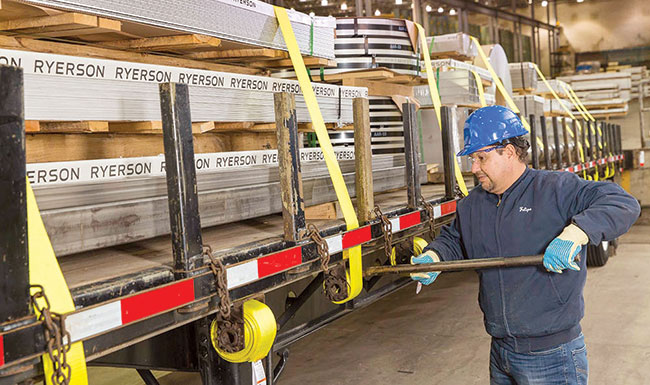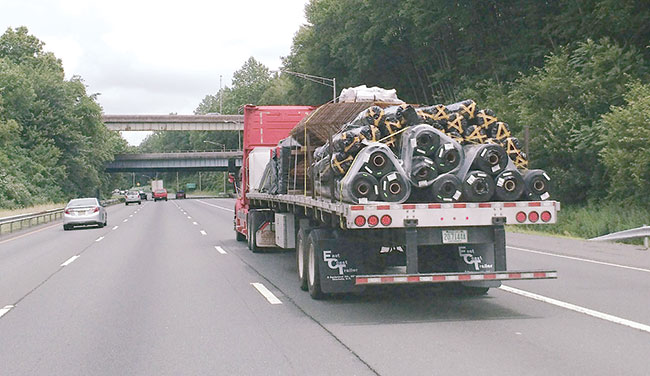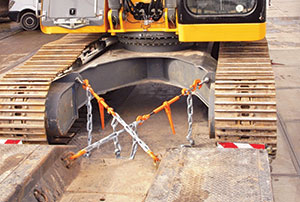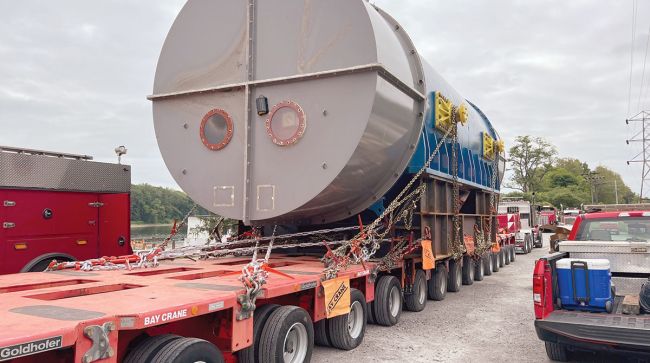When it comes to cargo securement, a flatbed is often like a stage that all the world — or nearby drivers — can see. Making sure flatbed cargo is secured for transit goes beyond meeting applicable regulations, which cannot cover every contingency, experts contend.
“[Flatbeds] are very visible,” said Kerri Wirachowsky, director of roadside inspection programs for the Commercial Vehicle Safety Alliance, of cargo securement problems. “They’re easily identifiable by inspectors either at a scale or on patrol.”
Wirachowsky and other experts agree that cargo securement requires skill, knowledge and creativity.
“The biggest challenge is the variety of products and the unique securement needs for each one of them,” said Kimberly Maes, president of the flatbed and specialized group of Roehl Transport. “Lumber is very different than coils. Depending on the position of the coils you need to do something different.” Maes contrasted the demands of securing machinery versus tubing, and said, “There’s just a whole lot of different types of materials and products that you can haul on the back of a standard flatbed.”

A Ryerson driver checks his load. The biggest challenge, fleet managers say, is the variety of products and the unique securement needs for each one of them. (Ryerson)
Based in Marshfield, Wis., Roehl Transport ranks No. 73 on the Transport Topics Top 100 list of the largest for-hire carriers in North America.
The key to cargo securement is to use more than the number of tie-downs prescribed by Federal Motor Carrier Safety Administration regulations, experts including CVSA’s Wirachowsky said. “If you’re tying down to the minimum requirements — for instance, you need five tie-downs and you put on five, none of them can tear, none of them can be loose — nothing can happen, all day. Put on six or seven and now one can go loose and you won’t be out of service.” The driver will still incur a violation, she noted.
For a driver or shipper wondering whether another tie-down is needed, “The answer is yes,” Wirachowsky said. “Adding another tie-down is the right answer every time.”
In May, the CVSA conducted its annual 72-hour International Roadcheck, an inspection and enforcement initiative in Canada, Mexico and the U.S. More than 59,400 commercial motor vehicles were inspected in the three countries, and 81% of them did not have any out-of-service violations. CVSA highlights certain aspects of the roadside inspection for each year’s Roadcheck. Cargo securement was one aspect that received extra attention during the May 16-18 event, which was announced in advance. The number of cargo securement out-of-service violations that inspectors found in the U.S. was 1,969 or 12.4% of all out-of-service violations found during Roadcheck.
By regulation, drivers are supposed to stop and check their load, making sure that binders haven’t loosened because of vibration, bouncing and jostling that occur as a matter of course in transit.

By regulation, drivers are supposed to stop and check their load, making sure that binders haven’t loosened because of vibration. (Peggy Smith/Transport Topics)
Wirachowsky cited FMCSA regulations stipulating that drivers are required to “inspect the cargo and the devices used to secure the cargo within the first 50 miles after beginning a trip and cause any adjustments to be made to the cargo or load securement devices as necessary, including adding more securement devices, to ensure that cargo cannot shift on or within, or fall from the commercial motor vehicle.”

Wirachowsky
Flatbed drivers are following that regulation when they are “pulled over at the side of the road or they’re at a truck stop, and they’re going around and they’re re-checking all their binders,” Wirachowsky said.
Binders, including straps and chains, are designated with a “working load limit,” or WLL, “which indicates how many straps or chains needed to utilize,” Roehl Transport’s Maes said. “It’s actually quite a bit more complicated than most people would think.”
The fleet’s flatbed and specialty group operates more than 500 tractors. To ensure that drivers have “the right understanding, depth and appreciation for the importance” of cargo securement, Roehl starts newly hired drivers with a five-day “hands-on” securement class, Maes said. “They have the opportunity to pull apart loads, put them back together, see them live,” she said. “We think that’s very important.
“Depending on the experience level of our drivers we have them take pictures of their loads and their securement and then send them in to their leaders,” Maes added. The leaders double-check the securement based on the images “and talk them through it if they may have missed something,” Maes said.
Driver turnover being a steady factor in trucking means that the need for training is ongoing for carriers, Maes acknowledged.
“We certainly invest in our training, but even if we have a driver that leaves us and goes someplace else, we still want them to be safe. So, we think it’s well worth the investment, because we’re not just thinking about our own bottom line, we’re also thinking about the safety of everyone around us.”
Federal Motor Carrier Safety Regulations Parts 392 and 393 deal with cargo and its securement. Ralph Abato, president and managing director of manufacturer Doleco USA, noted that a Drivers Handbook on Cargo Securement, containing FMCSA’s regulations, classifies different commodities and sets standards for proper securement of about a dozen load types, including logs, dressed lumber, metal coils, paper rolls, concrete pipe, heavy vehicles, equipment and machinery, and flattened or crushed vehicles.

The combined ratings of straps or chains must equal at least one-half the load’s total weight and the working load limit on the tie-downs must be legible to remain in service. (Doleco USA)
Doleco USA manufactures load-securing equipment including cables, slings and a textile “chain” that it introduced to the U.S. market more than three years ago. Abato, who has served in various positions with the Web Sling and Tie Down Association, wrote about the necessity of knowing a cargo’s weight to understand performance criteria — breaking strength and the working load limit — of tie-down assemblies including “chains, wire rope, steel strapping, synthetic webbing and cordage.”
The combined ratings of straps or chains must equal at least one-half the load’s total weight. If the load is 80,000 pounds, the WLL of all the tie-downs together must equal at least 40,000 pounds. The WLL on the tie-downs must be legible to remain in service, Abato noted.
Wirachowsky explained that the driver isn’t always the one who ties down the load, but they must examine it, do a trip inspection, “and if the load’s not [in compliance] then they can’t take it.”
“Because once they pull it, it’s the driver and motor carrier’s responsibility,” she said.

Bray
Thomas Bray, senior industry business adviser for J.J. Keller & Associates, warned about what he called the “I’m-only-going-20-miles mindset.”
“You can be pulling out of the driveway of a lumber mill or a steel mill and do something that’ll cause you to spill the load. It’s not a function of distance,” he explained. “It’s a function of, ‘What do I have to do to keep it on the trailer?’ That’s where sometimes drivers take shortcuts that create problems. The risk takes place the minute you start rolling.”
Jesse Krum, transportation projects manager for Bay Crane, a company in Long Island City, N.Y., that specializes in moving outsized cargo such as girders, track and aircraft, noted the load securement formula is the same whether it’s a smaller load or a larger load. “The distance of the haul doesn’t really matter either,” he said. “It’s all the same basic principles.”
For certain specialty jobs, Bay Crane has resorted to custom binders, Krum said. “Usually, we’re just using the standard chains and binders, just more of them to cover the correct working load limit.”
Because drivers typically deal with something different on each trip, it comes down to being able to be creative to attach the securement in the right way for different loads. However, Krum suggested the creativity usually amounts to just going overboard by “doing what ‘the books says’ and then doing, also, what you think is safe on top of that.”
As for training, Krum said, “We usually try to put a newer person with a more experienced driver to learn the ropes while also providing them with the regulations so that they know firsthand what’s going to be expected of them during an inspection.”






